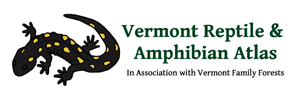Digital 2018 Edition
This digital version of the atlas provides online the maps that show where in Vermont a given species has been reported, how recently, and what kind of information has been reported. The atlas was updated in 2018, and maps are free to view or download. Feel free to print, distribute, or copy any of these maps, providing you give credit for them. The atlas was compiled by Jim Andrews, with cartography by Kiley Briggs. Technical assistance was provided by Cynthia Brown, and web site updates by Kir Talmage, Kiley Briggs, with help from Kate Kelly.
This atlas is not designed to impress you with how much we know about the distribution of Vermont herps, but rather with how easily you can help. We hope that it will motivate some of you to contribute new or more up-to-date records of Vermont’s reptiles and amphibians. We still have gaps in our knowledge of the distribution of many species within Vermont and would very much appreciate any assistance you could give us in closing those gaps.
These distribution maps show that we are missing records of even common species from many Vermont towns. We welcome your reports on all species, including common ones such as North American Snapping Turtles and Eastern Milksnakes. As you would expect, we have even larger gaps in our knowledge of the rarer species.
If you know of other individuals or organizations who might be interested in contributing records or who should know about this project, let us (and them) know.
Survey Effort and the Updated Atlas
Since the Preliminary Atlas was produced in 1995, we have had roughly 500 contributors per year (590 in 2017) contribute over 80,000 new records. We now have over 100,000 reports in our database. Of these records, roughly 72,000 are amphibians and 26,000 are reptiles. The remaining reports are of crossing areas, denning areas, egg-laying sites, vernal pools, research sites, and other herptile-related locations. The distribution patterns of our reptiles and amphibians are becoming clear. This makes it much easier to spot and target the remaining gaps in our reports. An empty space within a distribution map is just waiting to be filled in by you.
Take a careful look at the individual maps of species records. We suspect that many of you will find that you are aware of species that are not reported from your area. You can also use our searchable table to easily check to see specifically what data we need for any species in your area. We hope that once you know how valuable your field sightings are, you will take a few minutes to fill out a report form (or send an e-mail) the next time you find a reptile or amphibian. Feel free to use this reference map of Vermont Town and County names.
If you prefer to print a copy, we offer these maps as PDF files also.
| Survey Effort Map (2024): which towns in Vermont have had the most species reported |
Preview | Download Full Size |
| Vermont Towns and Counties | Preview | Download Full Size |

